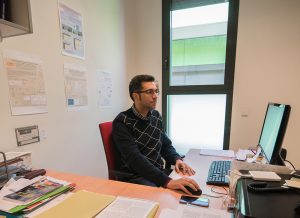 Andrés Suárez studied Chemistry at the University of Sevilla (1992-1997). In 1997, he started a PhD Thesis at the Instituto de Investigaciones Químicas (CSIC-Universidad de Sevilla), carrying out research in the field of enantioselective catalysis, more specifically in synthesis of new chiral phosphorous ligands and their applications in enantioselective hydrogenation and hydroformylation reactions. After receiving his PhD, he undertook postdoctoral studies at the group of Prof. Gregory C. Fu (Massachusetts Institute of Technology, 2003-2004). In 2005, he returned to the Instituto de Investigaciones Químicas, in which he holds a permanent position since 2006, initially as R&D Technician and currently as Tenured Scientist. He has been visiting researcher at ICCOM-CNR (Florence, 2002, Prof. Maurizio Peruzzini) and at the Universities of Oxford (2002, Dr. John M. Brown) and Heidelberg (2013, Prof. Lutz H. Gade).
Andrés Suárez studied Chemistry at the University of Sevilla (1992-1997). In 1997, he started a PhD Thesis at the Instituto de Investigaciones Químicas (CSIC-Universidad de Sevilla), carrying out research in the field of enantioselective catalysis, more specifically in synthesis of new chiral phosphorous ligands and their applications in enantioselective hydrogenation and hydroformylation reactions. After receiving his PhD, he undertook postdoctoral studies at the group of Prof. Gregory C. Fu (Massachusetts Institute of Technology, 2003-2004). In 2005, he returned to the Instituto de Investigaciones Químicas, in which he holds a permanent position since 2006, initially as R&D Technician and currently as Tenured Scientist. He has been visiting researcher at ICCOM-CNR (Florence, 2002, Prof. Maurizio Peruzzini) and at the Universities of Oxford (2002, Dr. John M. Brown) and Heidelberg (2013, Prof. Lutz H. Gade).
Current Research Areas
- Ligand design: Lutidine-derived pincer ligands, N-heterocyclic carbene ligands.
- Homogeneous catalysis: (de)hydrogenation reactions for synthesis and H2-storage, hydrosilylation and hydroboration reactions
- Ligand-stabilized metal nanoparticles (in collaboration with Patricia Lara, IIQ)
Selected recent publications:
1.- J. P. Morales-Cerón, P. Lara, J. López-Serrano, L. L. Santos, V. Salazar, E. Álvarez, A. Suárez. Rhodium(I) complexes with ligands based on N‑heterocyclic carbene and hemilabile pyridine donors as highly E stereoselective alkyne hydrosilylation catalysts. Organometallics 2017, 36, 2460−2469 (DOI: 10.1021/acs.organomet.7b00361).
2.- P. Sánchez, M. Hernández-Juárez, E. Álvarez, M. Paneque, N. Rendón, A. Suárez. Synthesis, structure and reactivity of Pd and Ir complexes based on new lutidine-derived NHC/phosphine mixed pincer ligands. Dalton Transactions 2016, 45, 16997–17009 (DOI: 10.1039/c6dt03652j).
3.- L. Ortega-Moreno, R. Peloso, C. Maya, A. Suárez, E. Carmona. Platinum(0) olefin complexes of a bulky terphenylphosphine ligand. Synthetic, structural and reactivity studies. Chemical Communications 2015, 51, 17008-17011 (DOI: 10.1039/c5cc07308a).
4.- M. Hernández-Juárez, J. López-Serrano, P. Lara, J. P. Morales-Cerón, M. Vaquero, E. Álvarez, V. Salazar, A. Suárez. Ruthenium(II) complexes containing lutidine-derived pincer CNC ligands: Synthesis, structure, and catalytic hydrogenation of C=N bonds. Chemistry A European Journal 2015, 21, 7540-7555 (DOI: 10.1002/chem.201406040).
5.- P. Lara, A. Suárez, V. Collière, K. Philippot, B. Chaudret. Platinum N-heterocyclic carbene nanoparticles as new and effective catalysts for the selective hydrogenation of nitroaromatics. ChemCatChem 2014, 6, 87-90 (DOI: 10.1002/cctc.201300821).
6.- M. Hernández-Juárez, M. Vaquero, E. Álvarez, V. Salazar, A. Suárez. Hydrogenation of imines catalysed by ruthenium(II) complexes based on lutidine-derived CNC pincer ligands. Dalton Transactions 2013, 42, 351-354 (DOI: 10.1039/c2dt31907a).
7.- M. Vaquero, A. Suárez, S. Vargas, G. Bottari, E. Álvarez, A. Pizzano. Highly Enantioselective Imine Hydrogenation catalyzed by Ruthenium phosphane-phosphite diamine complexes. Chemistry: A European Journal 2012, 18, 15586-15591 (DOI: 10.1002/chem.201203193).
Recent patent applications:
1.- A. Suárez Escobar, P. Lara Muñoz, K. Philippot. Noble metal nanoparticles coated with terphenylphosphine ligands for H2 generation from ammonia-borane and alcohols. Eur. Patent (2016)16382444.
2.- P. A. Kleman, A. Suárez Escobar, A. Pizzano Mancera. Catalizadores de hidrogenación enantioselectiva basados en fosfina-fosfitos quirales enlazados a resinas de poliestireno. Eur. Patent (2011)30904.
Research lines/topics/projects
Metal complexes incorporating proton-responsive lutidine-derived pincer ligands.
- Lutidine-derived pincer ligands are an interesting class of derivatives that may get involved in metal-ligand cooperation in a catalyic or stoichiometric process. So far, we have studied systems based on CNC, CNP and CNN pincers (C = N-heterocyclic carbene, P = phosphine, N = amine) that have been employed in a diversity of (de)hydrogenation reactions for organic synthesis and H2-storage, as well as in hydrosilylation and hydroboration reactions.
